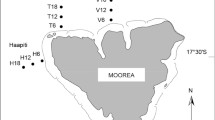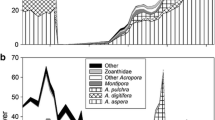Abstract.
Trends in the health of coral reefs worldwide were examined by surveying the literature for quantitative studies of coral abundance that were at least four years long and contained data on variance among samples. Of the 65 examples in which sufficient data exist to make a judgment, coral cover did not decline in 29%, with fewer declines in the Indo-Pacific than in the W. Atlantic. Coral cover declined and recovered in 29% (all in the Indo-Pacific) and declined but did not recover in 42% of the examples (16% in the Indo-Pacific and 26% in the W. Atlantic). Thus, coral assemblages were relatively stable over ecological time scales in 58% of the examples surveyed. However, the W. Atlantic region was more unstable than the Indo-Pacific; declines without subsequent recovery occurred in 57% of W. Atlantic examples but in only 29% of those in the Indo-Pacific. The principal reason corals recovered in some local sites but not in others seems to be related to the type of disturbance that caused the decline. Coral cover recovered after 69% of the acute, short-term disturbances but after only 27% of the chronic, long-term ones.
Similar content being viewed by others
Author information
Authors and Affiliations
Additional information
Accepted: 17 January 1997
Rights and permissions
About this article
Cite this article
Connell, J. Disturbance and recovery of coral assemblages. Coral Reefs 16 (Suppl 1), S101–S113 (1997). https://doi.org/10.1007/s003380050246
Issue Date:
DOI: https://doi.org/10.1007/s003380050246




